Zirconia and porcelain-fused-to-metal (PFM) are the two dominant choices for full-arch implant restorations, but they differ in composition, strength, esthetics, and long-term reliability. In long-span designs, decisions hinge on stability, predictability, and cost control. A clear understanding of these trade-offs enables faster approvals and fewer remakes.
On material and clinical performance, zirconia is monolithic and metal-free, delivering high bulk strength and chip resistance when kept monolithic. PFM pairs a metal framework with layered porcelain that can look very natural but is more prone to veneer chipping and margin shadowing. Under heavy occlusal forces and in full-arch/long-span cases, zirconia generally maintains framework stability with fewer technical events, while PFM remains practical where space is limited or specific layering effects are desired.
On value, workflow, and risk, zirconia often starts with a higher unit price but aligns with digital CAD/CAM production, lower remake rates, and more consistent turnaround, improving total cost of ownership (TCO) over time. PFM can be cost-effective upfront yet carries higher porcelain repair exposure. The best choice balances esthetics, durability, TCO, and workflow integration. Procurement teams that evaluate these four levers—material properties, clinical performance, cost & workflow, and risk & reliability—reduce rework, improve long-term outcomes, and stay aligned with the digital workflows shaping restorative dentistry.
What Material Properties Differentiate Zirconia and PFM for Full-Arch Implant Restorations?
For full-arch implant restorations, monolithic zirconia concentrates bulk strength in a one-piece design and lowers veneer-related risks, while PFM relies on a tough metal framework covered by porcelain that can chip under load. Esthetics often favor zirconia in high-smile lines because there is no metal show-through. Over time, differences appear as maintenance patterns: zirconia limits veneer events when kept monolithic; PFMs remain structurally robust but accumulate porcelain service in heavy function. Findings in a 2024 systematic review comparing zirconia-ceramic and metal-ceramic on implants support these trends. Read the 2024 implant review.
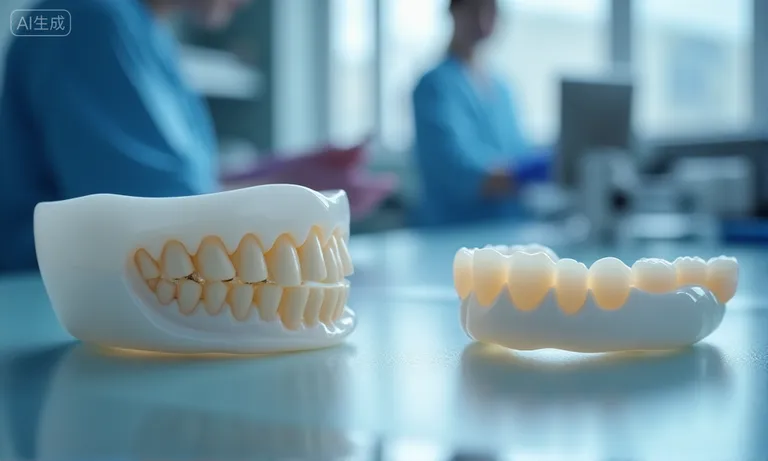
Full-arch-Zirconia-vs-PFM-Material-Setup
How Do Bulk Strength and Veneer Chipping Risks Compare?
- Zirconia (3Y/4Y) frameworks show high flexural strength with low framework-fracture risk when connector cross-sections meet design rules; undersized connectors raise the odds of breakage. See observational parameters linking connector size to fracture risk in full-arch zirconia. Connector dimensions and fracture risk.
- PFM frameworks rarely break, but veneering porcelain is the weak link; layered ceramics exhibit higher rates of chipping/delamination under occlusal stress compared with monolithic designs. See porcelain veneer chipping patterns in implant prostheses. Veneer chipping patterns on implants.
- Across implant-supported multi-unit FDPs, survival is high for both categories, with zirconia reducing veneer events when monolithic. 2024 zirconia-vs-metal-ceramic meta-analysis.
When Do Translucency and Metal-Free Margins Change Material Choice?
Zirconia avoids gray margins and helps blend with soft-tissue shades, which matters in thin tissue or high-smile cases. PFMs can deliver lifelike layering, yet managing the metal–porcelain junction becomes critical in full-arch lines. Reviews consistently note esthetic advantages for metal-free margins when tissue thickness is limited.
What Maintenance Patterns Define Long-Term Durability?
Monolithic zirconia reduces veneer-chipping callbacks and allows re-polishing after occlusal adjustment. Antagonist wear is technique-sensitive: evidence favors a high-polish finish over heavy glaze for enamel friendliness—see antagonist wear with polished versus glazed zirconia. Polished vs glazed zirconia and enamel wear.
PFMs age well structurally but accumulate veneer microfractures in heavy function. Recent reviews of implant-supported prostheses report very high short-term survival for monolithic zirconia arches and excellent survival for metal-ceramics, with complication types differing rather than early catastrophic failures.
Procurement teams can meet clinical goals with either material; the better choice aligns with arch design, bite force, and acceptable maintenance over time. As an overseas dental lab partner, we help map these trade-offs to target strength, esthetics, and service risk.
How Do Zirconia and PFM Perform in Full-Arch and Long-Span Implant Cases?
In full-arch and other long-span designs, monolithic zirconia favors framework continuity and chip resistance, while PFM relies on a strong metal substructure but carries higher veneer-related risks under heavy function. Both can reach high survival; the practical difference is how they handle bite stress, connector design, and the kind of service events that appear over time.
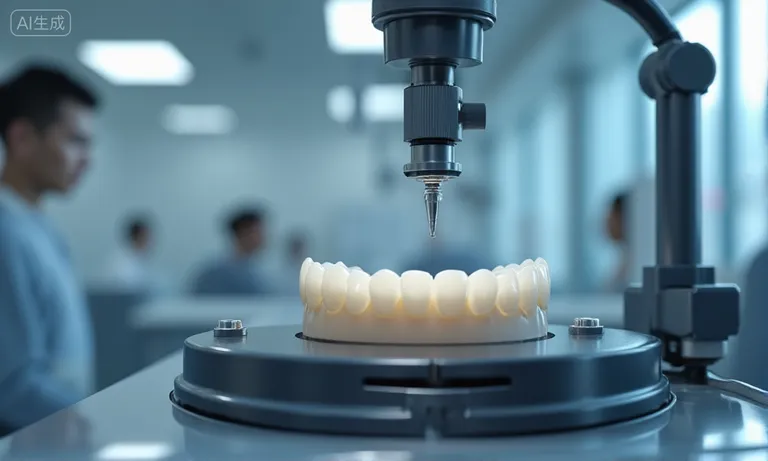
Image
ALT: Long-span-framework-stress-simulation
Prompt: A highly realistic, ultra-detailed, professional-quality photo captured in a clean, well-lit environment. Materials must be photorealistic, and rendered with DSLR-level clarity. Lighting should be soft daylight or studio white light, avoiding cold or bluish clinical tones. A lab stress-testing scene shows a long-span full-arch bridge on a loading device, with a zirconia one-piece arch beside a PFM metal framework; distant view, restorations slightly defocused; a Chinese technician monitoring a gauge; no exaggerated close-ups.
Why Does Framework Stability Decide Long-Span Success?
- Continuous zirconia frameworks spread load along the arch; undersized connectors raise fracture risk. See design notes in this connector dimension guidance for long-span zirconia frameworks.
- PFM frameworks resist catastrophic break, but porcelain layers act as a failure fuse under cyclic load.
- Cross-arch rigidity, connector height/width, and occlusal scheme matter more than the material label in isolation.
Complication Profile Under Heavy Occlusion (Full-Arch Use)
| Scenario | Zirconia (Monolithic) | PFM (Metal-Ceramic) |
|---|---|---|
| Framework integrity | Rare when connectors are adequate | Very stable metal substructure |
| Veneer/Surface issues | Minimal if monolithic; wear risk if rough finish | Higher veneer chipping/delamination in long spans |
| Maintenance focus | Polishing, minor occlusal refinements | Veneer repairs, reglaze, occasional remakes of veneered segments |
| Opposing dentition | Favor high-polish to limit enamel wear | Softer porcelain may scuff; chips trigger repairs |
What Do Cohort and Review Data Show?
Recent reviews of implant-supported prostheses describe high survival for both categories in full-arch use, with different complication patterns: zirconia frameworks lower veneer events when kept monolithic, while metal-ceramic systems report more porcelain chipping over time. See clinical outcomes of full-arch monolithic zirconia prostheses and veneer chipping patterns in implant prostheses. For long-span zirconia, connector sizing and cross-section remain key design controls as noted in the connector dimension guidance for long-span zirconia frameworks.
For programs handling bruxism or heavy bites, prioritize cross-arch rigidity, connector rules, and a polishing protocol. Raytops Dental Lab integrates these controls in trial runs and communicates risk thresholds early, so teams can match material choice to real occlusal demands rather than preference alone.
What Are the Cost and Value Differences for Full-Arch Implant Restorations?
For full-arch cases, zirconia often carries a higher unit price but a lower maintenance burden, while PFM can start cheaper yet trend higher in service costs if veneer events accumulate. The most reliable comparison is not sticker price; it is total cost of ownership across the life of the restoration, including shipping, chairtime, and remakes. Evidence on complication profiles helps explain why TCO diverges—see this 2024 systematic review on zirconia-ceramic vs metal-ceramic implants.
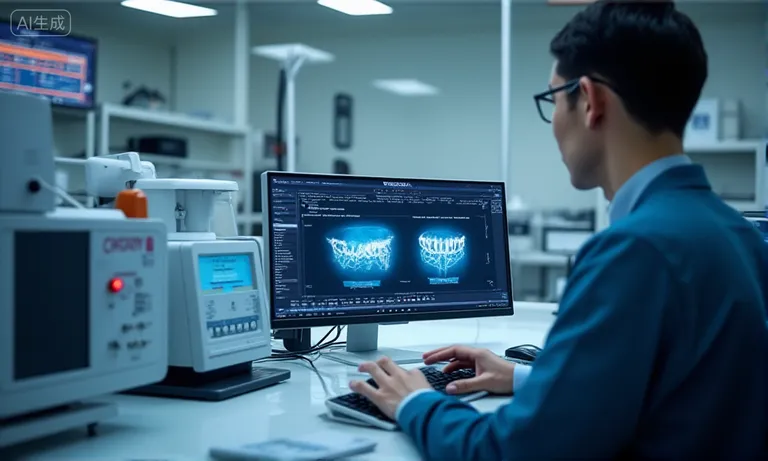
TCO-comparison-full-arch-restorations
What Drives the Upfront Price Gap?
- Material and CAM time: zirconia blocks, nesting, milling hours, and sintering cycles add machine cost; PFM pays more in metal casting and porcelain layering time.
- Labor mix: zirconia shifts effort to CAD/CAM technicians and finishing; PFM concentrates manual veneer steps that vary by ceramist.
- Risk buffers: vendors may price-in remake allowances differently for long-span PFMs versus monolithic arches. Freight and customs also move the baseline for overseas programs.
Why Do Longevity and Remake Rates Shape Total Cost of Ownership?
| Cost Driver | Zirconia (Monolithic) | PFM (Metal-Ceramic) | Cost Signal |
|---|---|---|---|
| Typical technical events | Polishing, minor occlusal refinements | Veneer chips/delamination more common | Service frequency differs |
| Chairside time per event | Short (polish/adjust) | Longer (repair/reglaze; may recement) | Clinician hours add up |
| Probability of remake | Lower if connectors adequate | Higher when veneer damage is extensive | Shipping + lab remake fee |
Trends in veneer complications are described here: porcelain veneer chipping patterns in implant prostheses.
How Should Procurement Teams Evaluate ROI?
- Define annual case volume and expected service life (years in function).
- Model unit lab fee + logistics per arch (shipping, customs, handling).
- Add maintenance assumptions: event type, probability, and chairtime.
- Include remake policy terms and turnaround impact on scheduling.
- Convert to TCO per arch-month; compare scenarios for heavy bite vs normal load.
- Stress-test with ±20% swings in event rates to see sensitivity before committing.
For multi-site programs, this approach clarifies when a higher zirconia price is offset by lower service. Raytops Dental Lab provides line-item pricing, maintenance assumptions, and trial-run baselines so teams can see TCO and ROI before scaling.
How Does the Lab Digital Workflow Differ Between Zirconia and PFM?
Zirconia production is CAD/CAM-first and repeatable: scan → design → mill → sinter → finish. PFM relies on a metal substructure plus hand-layered porcelain, so quality depends more on individual ceramists and bench time. Digital compatibility (files, libraries, CAM capacity) is what compresses turnaround and makes multi-site scaling realistic.

Digital-workflow-cad-cam-zirconia
What Does CAD/CAM Change in Zirconia Production?
- Design is parameter-driven (connector height/width, emergence, minimum thickness) and can be saved as templates in exocad/3Shape, improving repeatability across cases. See the exocad DentalCAD workflow overview.
- Milling and sintering add predictable shrink factors; finishing is mainly pre-polish and characterization rather than layered porcelain.
- The main risks are digital: library mismatch, scan noise, or missed occlusal stops—issues that are easier to audit upstream than to fix after firing.
Why Is PFM More Labor-Dependent, and How Does That Impact Consistency?
| Stage | Typical Bottleneck | Variability Driver |
|---|---|---|
| Metal framework | Casting/laser-weld fit checks | Alloy choice, investment, devesting |
| Porcelain build-up | Multiple firing cycles | Individual layering style & firing curve |
| Characterization | Shade/texture by hand | Ceramist skill and shift changes |
PFM can look excellent but scales less predictably across batches, especially for long-span arches.
How Does Digital Compatibility Improve Turnaround and Throughput?
- Intake files in open STL/PLY with an order form (implant system, MUA library, screw-channel plan). Use a shared naming rule: site-arch-date-caseID.
- Validate scans with an automated checklist (margin flags, bite stability, soft-tissue thickness markers).
- Lock a design template per indication (full-arch, long-span) to keep connectors and emergence consistent.
- Batch mill by material and thickness; sinter overnight; pre-polish before try-in.
- Ship with a QC slip: library version, connector sizes, torque note, and a re-polish protocol.
In a six-site pilot, one screw-channel misalignment traced back to a mismatched MUA library. We unified the 3Shape library version, enforced a standard file name, and added “library version + connector size” to the QC slip. Subsequent batches shipped by the third working day with no recurrence. The transferable insight is simple: at scale, template + library + naming keep throughput stable.
Digital does not automatically mean faster; it makes speed and consistency controllable. As an overseas dental lab, Raytops Dental Lab pushes templates and QA gates into the trial phase so multi-site teams gain predictable turnaround without trading off esthetics.
What Risks and Quality Control Issues Matter Most in Full-Arch Cases?
In full-arch implant work, risk clusters fall into three buckets: material-specific complications, bite-force amplification across long spans, and preventable remake triggers inside the lab workflow. Managing these three early—at design and QC—cuts most downstream service events.
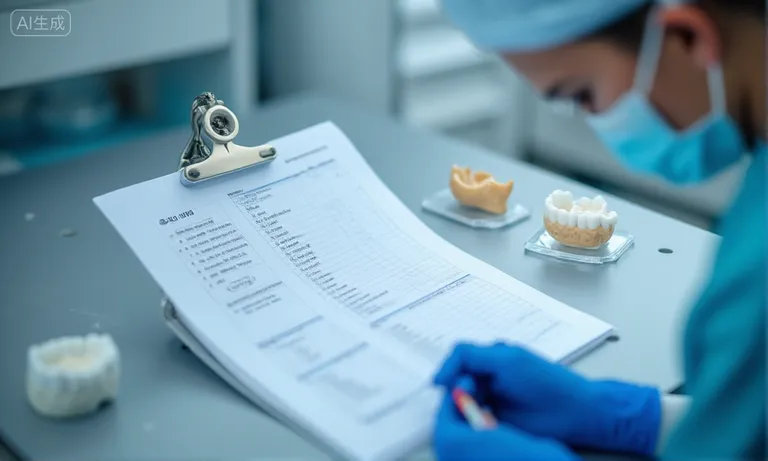
QA-gates-implant-full-arch
What Complications Are Typical with Zirconia?
- Veneer events are low when designs are monolithic; layered zones near incisal edges need extra margin for chip resistance.
- Antagonist wear depends on finish quality; a high-polish surface is more enamel-friendly than heavy glaze—see antagonist wear with polished vs glazed zirconia.
- Framework fractures are uncommon when connector height/width meet rules; undersizing, deep occlusal notches, or aggressive intraoral adjustments increase risk.
How Do PFM Failures Present in Full-Arch or Long-Span Cases?
- Cohesive porcelain chips and delamination at high-stress sites (connector corners, heavy-function cusps) are the most frequent service events—see porcelain veneer chipping patterns in implant prostheses.
- Microcracks grow with repeated firing or thick glaze repairs; shadows at the metal–porcelain junction may appear in thin tissue, prompting esthetic revisions.
- Framework breakage is rare; most remakes originate from extensive veneer loss or esthetic mismatch after multiple repairs.
Which QA Gates Reduce Remakes in Full-Arch Cases?
| QA Gate | What to Check | Prevents |
|---|---|---|
| Incoming scan QC | Bite stability, tissue thickness markers, scan noise | Occlusal high spots, soft-tissue misread |
| Library/version lock | Implant/MUA library and lot on the job ticket | Misaligned screw channels, seating issues |
| Connector audit | Minimum height/width by site; cross-arch rigidity | Framework fracture risk |
| Finish grade | High polish documented; avoid thick glaze | Opposing enamel wear, surface crazing |
| Try-in protocol | Pre-polish, torque note, shimstock contacts | Post-delivery grind-in and microcracks |
| Packout checklist | Library version, connector sizes, re-polish protocol | Rework delays and ambiguous remakes |
Most “avoidable” remakes come from missing library control, undersized connectors, or finish variability—not from the material itself. As a global dental lab partner, Raytops Dental Lab builds these gates into trial runs so teams ship with clear specs and a predictable service profile.
Which Material Offers Greater Long-Term Value and Scalability for Full-Arch Programs?
For multi-site and growing programs, zirconia generally offers more predictable scaling because the CAD/CAM-heavy workflow keeps key variables templated and measurable. PFM can still deliver excellent results, but its hand-layered steps make batch-to-batch uniformity and capacity planning harder. Long-term value depends on how well the chosen material supports digital repeatability, manageable service events, and reliable turnaround across sites.
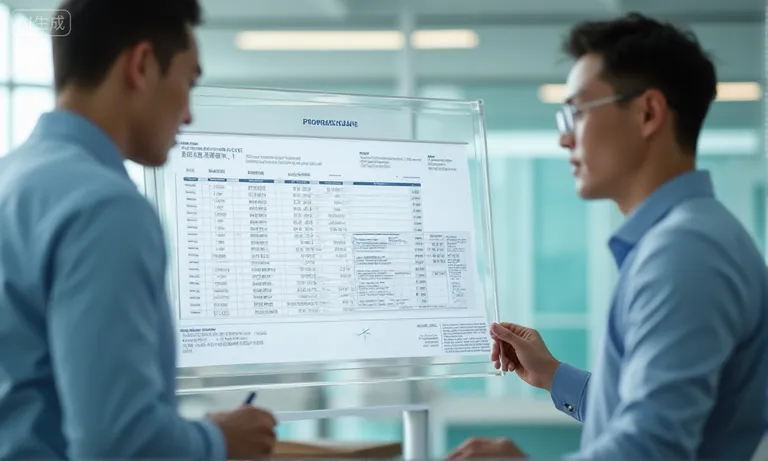
Scalable-full-arch-program-planning
How Do Zirconia Workflows Align with Digital Dentistry?
Zirconia slots into scan–design–mill–sinter pipelines where connector rules, emergence profiles, and finishing steps can be codified. That creates stable turnaround and clearer maintenance forecasting. Clinical literature shows strong survival for monolithic zirconia in full-arch use, with fewer veneer events than layered systems—see representative findings in clinical outcomes of full-arch monolithic zirconia prostheses.
When Does PFM Still Make Practical Sense?
- You need complex layered characterization in visible zones and can accept extra bench time.
- The program volume is modest, so capacity limits and shift-to-shift variance are manageable.
- A metal substructure is preferred for specific abutment strategies or legacy workflows already optimized around porcelain build-up.
Why Does Scalability Drive Long-Term Collaboration?
| Scale Lever | What Matters in Practice | Zirconia (Monolithic) | PFM (Metal-Ceramic) |
|---|---|---|---|
| Throughput | Batch design/milling; overnight sintering | Template-driven; capacity predictable | Hand layering limits batch size |
| Uniformity | Cross-site consistency | Parameters stored and audited | Ceramist style varies by shift |
| Service Profile | Type and frequency of events | Polish/adjust dominates | Veneer repairs accumulate |
| Planning | Lead time & logistics | Easier to model per arch | More variability to buffer |
If your roadmap includes higher volumes or multi-site rollouts, prioritize the option that turns design and finishing into rules, not exceptions. As an overseas dental lab, Raytops Dental Lab builds templates, library controls, and QC slips into trial runs so teams can scale without trading off esthetics or schedule.
Conclusion
Both zirconia and PFM can succeed in full-arch implant programs. The practical split is where value accrues over time: zirconia ties into digital workflows that scale with templates and clear QC, often reducing veneer-related service and stabilizing turnaround. PFM remains a strong choice for selective layered esthetics or legacy setups that prize a metal substructure. If your plan involves higher volumes or multi-site rollouts, align material choice with how you manage capacity, uniformity, and service risk. As an overseas dental lab, Raytops Dental Lab partners on trial runs, template control, and line-item transparency so programs grow with predictable quality and cost.


